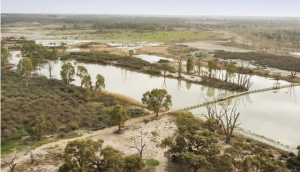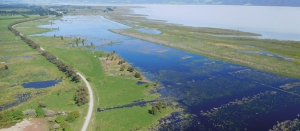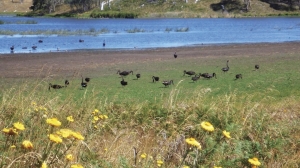Displaying items by tag: Wetlands
Wetland Day 2014
Coming soon – World Wetlands Day, the Ramsar Convention’s annual campaign day February 2, 2014. The theme this year is
Wetland and Agriculture, a topic of relevance to almost everyone involved in wetlands!
Visit the Ramsar Secretariat’s web site www.ramsar.org to find out more. Hard and soft copy materials (poster, leaflet, cartoon etc), will be available. Write now to This email address is being protected from spambots. You need JavaScript enabled to view it. to receive hard copies and the
design files if you wish to customise their materials.
Banrock Station wetlands get a boost
Nearly 700 hectares of wetlands at Banrock Station are being artificially flooded. This is the first time in five years the area near Kingston-onMurray, has seen flooding.
Banrock Station, in the South Australian Riverland, is on the Ramsar list of internationally significant wetlands.
A new regulator is pumping 2.4 gigalitres of water into the wetlands, a task which will take the next year.
Wetlands manager Christophe Tourenq said the process should mimic the natural wet-dry cycles of the flood plain, boosting the health of native plants and wildlife in the area.
Christophe said they had high water levels all spring and after that water levels would be reduced a little bit during summer.
“After that, again high levels next winter and then we start again to have a dry wetland in two years time.”
He said the process would recreate what happened before the construction of locks and weirs along the Murray River.
Story courtesy Wetland Care Australia.
Science in the Swamp - WETmak now live
WETmak is a free online Wetland Monitoring and Assessment Kit aimed at groups working on wetland restoration projects in New Zealand. It includes a range of monitoring techniques and methods of assessing the impact of restoration work, all designed to minimise the need for expensive or complicated equipment.
The kit is available in different formats to suit user needs. You can download the entire resource or focus on specific modules. Blank datasheets and report templates can be printed off or downloaded to fill in electronically.
Download WETmak, print out a few datasheets, pull on your gumboots and head out with friends to get measuring. Increasing understanding of your restoration work will bring huge rewards and provide useful information for future planning.
There are 40 Wetlands to visit. DoC in association with the National Wetland Trust has produced a booklet about the 40 wetlands you can visit.
Pick up a copy at your local DOC info centre or visit the DOC website to view them online.
A feature wetland is Nukuhous Saltmash, Burke Road, Ohiwa Harbour, Bay of Plenty.
Nukuhou Saltmarsh covers about 60 hectares where the Nukuhou
stream enters the Ohiwa Harbour. In 2003 the Nukuhou Saltmarsh Care Group was formed and with the help of the DoC and Environment Bay of Plenty, began a significant restoration and interpretation project.
Extensive plantings, weed and pest control, an overlook, interpretation panels, pottery bird plaques, a short boardwalk and a contemplation bench have made this a pleasant place to enjoy the wetland and listen quietly for fernbird calls (a high pitched single note).
Pest control has boosted fernbird numbers, as well as banded rail, Australasian bittern and waders.
Wetlands to protect
Wetland importance is often under-rated. Groups like our own DU, Wetland Care and the National Wetlands Trust are working towards reversing this trend.
There is a great diversity of wildlife in our wetlands with more native birds, fish,
invertebrates and plants than most other habitats, yet many wetland species are threatened with extinction. Wetlands have high recreational values, and perform vital ecosystem services such as improving water quality and reducing flood risks.
They have a big role in managing climate change. Healthy peat bogs are year-round sinks of 2-5 tonnes of carbon per hectare – locking it up in their soil indefinitely.
Wetlands are of cultural and spiritual significance to Maori. They provided Maori with food (wildfowl, eels and other freshwater fish), taro cultivation, harakeke (flax) for weaving and other materials for medicinal, food, building, and craft use.
A plethora of wetland to visit
Managed by DOC, the 5923ha of peat bog, swampland, mesotrophic lags, open water and river systems, is an important habitat for threatened species like Australasian bittern, grey teal, spotless crake, the North Island fernbird and black mudfish.
Firth of Thames
At the base of Coromandel Peninsula, the Firth of Thames has 8500ha of wide inter-tidal flats which attract thousands of migratory wading birds. Some make the arduous 10,000km journey south from the Arctic in spring and fly north again in the autumn; others fly 1000km north from the braided rivers of the South Island in the autumn and return in the spring.
Wairarapa Moana Wetlands Park
Lake Wairarapa, Lake Onoke and their associated wetlands make up the largest
wetland complex in the southern North Island, supporting native plants and animals of national and international importance.
The diverse habitats within Wairarapa Moana attract a wide range of wetland birds - about 100 species including international migratory birds.
Lower Kaituna Wildlife Reserve
Northeast of Te Puke, western Bay of Plenty, Kaituna is a reminder of how the country used to be with an abundance of cabbage trees and flax, pukeko prowling through raupo, numerous ducks, shags and pied stilts foraging for food in the waterways.
West Coast wetlands
The South Island’s West Coast has a variety of large and valuable wetlands, including lakes, swamps, fens, bogs, marshes, lagoons,
Ō Tū Wharekai wetland
Ō Tū Wharekai, covering the Ashburton lakes and Upper Rangitata River in Canterbury, is an unspoiled, intact, intermontane wetland system and is nationally important for wildlife.
Otago wetlands
Lake Waipori, Lake Waihola and their associated wetlands are the most significant waterfowl habitat in Otago 40km south of Dunedin. The lakes are shallow and drain through an extensive swamp into the Waipori River and then the Taieri River.
Over 60 species of bird live in or visit the wetland. It is now privately owned by Te Rūnanga o Ngāi Tahu and protected by a QE II National Trust Open Space Covenant.
More than 80 bird species have been sighted in the area, 65 of which are dependent on the estuarine environment.
Southland’s estuaries rank alongside Farewell Spit and Lake Ellesmere as the top three wading bird habitats in the South Island.
Planting continues at Wairio wetland
The water was quite high at Stage 4 so there are still some spots to be planted.
We still have 400 suitable plants at Norfolk Road Nursery and Don Bell will arrange for them to be planted when the water recedes. He will also plant about 100 Totara and
We did not do this during the July planting due to time constraints – priority was on getting the trees in the ground.
Jim Law
Our wetlands
The international theme of World Wetlands Day this year (2014) is “Wetlands and Agriculture: Partners for Growth”.
For millennia, wetlands have been used directly for agriculture and for supplying food, fuel and fibre to support lives and livelihoods.
Wetlands continue to play an essential role in supporting modern agriculture. They provide water storage, flood buffering, nutrient removal, water purification and erosion control. Sustainable practices which support both agriculture and healthy wetlands are therefore coming to the fore.
Australia was one of the first countries to sign the Convention on Wetlands of International Importance (more commonly known as the Ramsar Convention), and in 1974 designated the world’s first Ramsar site at Cobourg Peninsula in the Northern Territory. They beat
us by two years.
New Zealand became a party to the Ramsar Convention on Wetlands in December 1976 and has listed six sites covering almost 55,112 hectares in the List of Wetlands of International Importance.
They are:
- Whangamarino, Waikato
- Kopuatai Peat Dome, Waikato
- Firth of Thames, Waikato
- Manawatu River Estuary, Manawatu
- Farewell Spit, Nelson
- Awarua Wetland/Waituna Lagoon,Southland.
Protection plan for Mexico wetlands
The National Protected Natural Areas Commission, or Conanp, has released a plan to protect the 139 wetlands in Mexico, the country with the second-largest number of protected wetlands in the world.
“The national wetlands policy comes from recognition that these ecosystems are extremely vulnerable to climate change,” Conanp director Luis Fueyo said during the plan’s presentation in March in the south eastern state of Campeche.
New Wetlands education toolkit
The Queensland Wetlands Programme (QWP) in the Department of Environment and Heritage Protection recently completed a wetlands education toolkit as a teaching resource to complement the Science and Geography curriculums. The toolkit is aimed at the middle years of schooling and provides information on activities, field trips and learning opportunities relating to wetlands and water.
WetlandCare Australia restoring Little Llangothlin Lagoon
Little Llangothlin Lagoon is a rare and unique tableland wetland, internationally listed as one of the most important wetlands in the world!
WetlandCare Australia are currently working with landholders around the Lagoon planting trees, fencing and more to provide a buffer to this vitally important waterbird haven.
Protecting and restoring this wonderful wetland will not only provide secure habitat for wildlife and native plants, it will also improve the health of the entire catchment with benefits to local agriculture and communities long into the future from clean water, abundant wildlife
and healthy pastures.
The Little Llangothlin Lagoon catchment area is located on the Northern Tablelands near the township of Guyra in New South Wales. The Lagoon itself is a part of the Little Llangothlin Nature Reserve which covers an area of 258 hectares and is listed as an Australian Ramsar site.
Supporting various threatened plant and animal species, the Reserve incorporates several threatened ecological communities. Protecting these valuable ecosystems is key to securing the health of the catchment for years to come.
Arbor Day planting a tradition
Seven classes from Waikanae and Kapanui Schools were ‘eager beavers’ on Friday June 6, when around 1700 plants were planted on the west margin of the northern pond at the Pharazyn Reserve wetland near Waikanae.
The two local schools have been involved for some years now and the planting is a popular activity with the students.
This latest planting complements work done in previous years in the programme to re-habilitate a wetland margin around the former oxidation ponds for Waikanae that were de-commissioned in 2002.
To date approximately half of the margins have been planted over the last seven to eight years. The earlier plantings are doing extremely well with a number of the students proudly pointing out where they had planted in previous years.





